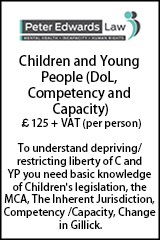Siblings, adoption and competing Article 8 rights to family life
- Details
A Family Court judge recently had to consider the respective Article 8 rights to family life of two children in a context where the potential outcomes for one child were clearer than for the other. Victoria Steet examines the outcome.
In O & G & L [2025] EWFC 21 (B) the Local Authority’s application concerned three children: O (age 9), G (age 3) and L (age 1). M had two older children, T who was living independently in supported accommodation, and Ta who was living with her father. At the time of the Final Hearing all three children were in separate foster placements.
This was the second set of proceedings and there was a significant history of social care involvement due to concerns largely surrounding domestic abuse, alcohol and substance misuse, neglect and dysregulated behaviour from the parents.
M did not attend the Final Hearing but had previously indicated that if the children could not return to her care, she would like L to remain in his current placement. F was also not in attendance and had very little involvement in the proceedings. There were no other family members able to care for the children and reunification was not a realistic option
Issue
The core question for the court was whether to endorse the LA’s care plan for L and G to be adopted together or allow the foster carers (Mr and Mrs K) to adopt L separately.
The CG agreed with the LA’s care plan to place O in long term foster care due to his age and connection to his birth family but supported the foster carers’ section 44 application to adopt L separately rather than the LA’s care plan.
Analysis
This was an interesting case as the court had to consider the respective Article 8 rights to family life of each child in a context where the potential outcomes for one child were clearer than for the other, as well as determining the weight which should be afforded to their relationship with the foster family in comparison with their birth family.
L had lived with his foster family since birth (aside from a short-lived attempt at reunification) and as such, was found to have an ‘established and settled’ family life with Mr and Mrs K. The judge recognised each child’s potential to build lasting relationships in their placements, but in particular for L with the five other children (biological and foster) living with Mr and Mrs K. By contrast, G had experienced greater disruption and trauma having been removed from his mother twice and experiencing different foster placements, both with O and alone.
At the outset of her judgment, the judge stated ‘there is no simple formula either in social work practice or law for choosing between the competing rights of minor children where those are seen not to be consistent with each other and the court has to assess the benefits and disadvantages to each child alongside the others…the aim is always to achieve the best possible outcome for all the children concerned [7].’
Having accepted removal from the foster carers would constitute a traumatic loss for L, the LA’s care plan was premised on the view that this detriment would be outweighed in the long term by the benefit of being brought up with his sibling and a shared experience. In her evidence, the social worker (SW1) referred to L’s ‘right’ to be adopted with his sibling but described the decision to seek placement of the siblings together as a ‘very finely balanced decision.’ No criticism was made of the foster carers who were described as ‘exceptional’ and highly experienced. The Annexe A report prepared by a different social worker recognised L’s integration into the foster carers’ family and community, but the ‘finely balanced’ recommendation was ultimately tipped by the ‘uncertainties’ about the future of the other foster children in that placement and the potential impact on L.
All the professionals agreed that as a fundamental principle, wherever possible ‘siblings should be given the opportunity of growing up together, particularly if they cannot grow up with their parents [26].’ However, in contrast to G and L’s case, the judge highlighted that in most cases where adoption is proposed, the siblings have entered local authority care together and are placed together because ‘they may understand each other’s experiences better than anyone else because those experiences have been shared or repeated in similar ways.’
Weighing up the benefits and disadvantages of each option, the judge considered removing L from the foster carers would be a ‘very significant loss’ at a ‘vulnerable stage in his development’ where, unlike for many children who are separated, the harm would not be ameliorated by the child’s awareness that care is better in the new placement. It was also considered L entering G’s secure placement would cause G a real disruption as L’s needs would be a lot greater, and the delay of a bridging placement would take him further outside the bracket for successful adoption.
Regarding contact, the judge acknowledged that the sibling relationship may not be as close if they do not live together but recognised the role of modern communication and social network. Furthermore, the foster carers had been incredibly supportive and proactive maintaining contact with L’s birth family and had a good relationship with M.
In terms of identity, the judge rejected the LA’s assertion that L might find it confusing in a household where his parents have other foster and birth children. The judge was clear that ‘the blended family is so common nowadays that children are able to understand that their peers often have different labels attached to their relationships and, of course, if L is adopted he will be Mr and Mrs K’s son, equal to their birth children [32].’ While the LA argued placement together would enhance the siblings’ identity, the judge stated it was unclear what sense of identity G had. However, L’s identity is being ‘psychologically the child of the foster carers rather than either of his birth parents and the sibling of the children in that household [33].’
The judge was not persuaded the unknown impact of the three foster children’s presence created a risk which outweighed the benefits of L remaining in a stable placement. Acknowledging that neither the court nor the social worker has a ‘crystal ball’, the certainty for L was that his integration into the foster family had been true and absolute such that removal would cause L to suffer damage, loss and confusion. It was said that ‘for both children to move to the shared adoptive placement will be another trauma… for L the move from Mr and Mrs K will be the most significant trauma he has suffered yet [41].’
Outcome
Ultimately the judge had to decide what was in the best interests of each child. At [42 – 43] she stated that ‘I am not persuaded that the opportunity of growing up in the same household as G as opposed to simply spending time with him two or three times a year is sufficiently valuable to outweigh the loss on separation from his (L’s) foster family… however, I have to think of G. I have not been persuaded that it is so much more to G’s advantage or at all to have L move into his space that I should sacrifice L’s very positive start in life.
In the judge’s view it was overwhelmingly in L’s better interests to stay with the foster carers and not clear that it would be in G’s interests to have L move to him and then move together. The judge had been ‘careful not to allow the clear advantage of L’s placement with Mr and Mrs K to obscure the potential benefits of placing him with G or to neglect the importance of finding the best outcome for G [45].’
The guidance to keep siblings together was capable of being overridden based on proper consideration of the evidence that L is much more certain to have a good outcome with the foster carers, yet placement of L and G together is uncertain and untested. Overall, it was acknowledged that ‘this is not a simple decision: I am comparing one plan which is clear for one child and less clear for the other with a plan which is not so clear for both.’
The judge made an order in favour of the foster carers adopting L alongside a section 26 order for contact. An order was made for O to be placed in long term foster care and G to be placed for adoption on his own.
Victoria Steet is a pupil barrister at Pump Court Chambers.
Jayne Harrill, also of Pump Court, represented Mr and Mrs K (foster carers), instructed by Georgina Hancock at RWK Goodman.












































